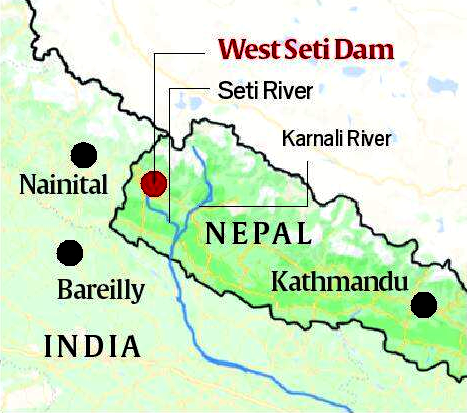West Seti Power Project: Nepal | 20 Jun 2022
For Prelims: India-Nepal Relations, India-Nepal Treaty of Peace and Friendship of 1950, West Seti Hydropower Project
For Mains: India-Nepal Relations and Significance
Why in News?
India will be taking over West Seti Hydropower Project nearly four years after China withdrew from it, ending a six-year engagement between 2012 and 2018.
- Earlier, the Indian Prime Minister visited Lumbini, where he celebrated 2566th Buddha Jayanti celebrations, also Nepal invited India to invest in West Seti Hydropower Project.
What is the West Seti Power Project?
- It is a proposed 750-megawatt Hydropower Project, which is to be built on the Seti river in far-western Nepal, which has remained on the drawing board for the last six decades.
- Lately, the government has remodeled the project as West Seti and Seti River (SR-6), a joint storage project, with the capacity to generate 1,200 megawatts of electricity.
- This storage or reservoir will fill up during the monsoon season and the water will be drawn to generate power during peak hours each day in the dry season.
- Its success is expected to restore India’s image in Nepal and give it weightage in future considerations for hydropower projects, when competition is bound to be tough. West Seti, therefore, has the potential to be a defining model for Nepal India’s power relations in future.
How have been India-Nepal Power relations?
- Nepal is rich in power sources with around 6,000 rivers and an estimated potential for 83,000 MW.
- Mahakali treaty was signed back in 1996, to produce 6,480 MW, but India has still not been able to come out with the Detailed project Report.
- The Upper Karnali project, for which the multinational GMR signed the contract, has not made any headway for years.
- India’s success in executing the 900-MW Arun Three project in eastern Nepal’s Sankhuwa Sabha, and whose foundation was laid in 2018 and which is set for completion by 2023 has helped build faith in India recently.
- During the Indian PM’s visit to Nepal in 2014, he had said India must start executing its projects timely.
- Nepal’s Constitution has a provision under which any treaty or agreement with another country on natural resources will require Parliament’s ratification by at least a two-thirds majority. That will also mean homework will be required before any hydro project is signed and given for execution.
- Nepal has a massive power shortfall as it generates only around 900 MW against an installed capacity of nearly 2,000 MW. Although it is currently selling 364 MW power to India, it has over the years importing from India.
How have been India-Nepal Diplomatic Ties?
- After a standoff between Nepal and India led to the economic blockade of 2015, equations changed after the new PM Deuba took over Oli, who visited India recently where he decided to establish Fraternal Ties with India.
- Nepal is an important neighbour of India and occupies special significance in its foreign policy because of the geographic, historical, cultural and economic linkages/ties that span centuries.
- India and Nepal share similar ties in terms of Hinduism and Buddhism with Buddha’s birthplace Lumbini located in present day Nepal.
- The two countries not only share an open border and unhindered movement of people, but they also have close bonds through marriages and familial ties, popularly known as Roti-Beti ka Rishta.
- The India-Nepal Treaty of Peace and Friendship of 1950 forms the bedrock of the special relations that exist between India and Nepal.
- Rivers originating in Nepal feed the perennial river systems of India in terms of ecology and hydropower potential.
- However, the border issue erupted in November 2019 when Nepal had released a new political map that claims Kalapani, Limpiyadhura and Lipulekh of Uttarakhand as part of Nepal’s territory. The area of Susta (West Champaran district, Bihar) can also be noted in the new map.
Way Forward
- Until India agrees to value Nepal’s water and the existing focus on power is not reviewed, mutual distrust will continue to eclipse the potential for progress of both sides in the long term.
- Once the projects are made multi-purpose — with flood control, navigation, fisheries, irrigation contributing to agricultural growth etc, giving due value to water — the cost of power will be much lower compared to existing rates, and people on both sides will have multiple benefits.
- The power trade agreement needs to be such that India can build trust in Nepal. Despite more renewable energy projects (solar) coming up in India, hydropower is the only source that can manage peak demand in India.

